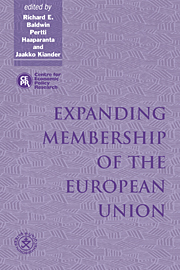Book contents
- Frontmatter
- Contents
- List of figures
- List of tables
- Preface
- Acknowledgements
- List of conference participants
- 1 Introduction
- PART ONE THEORETICAL ISSUES
- PART TWO POLICY ISSUES
- PART THREE EMPIRICAL ISSUES
- 8 Regional effects of European integration
- 9 Implications of EU expansion for European agricultural policies, trade and welfare
- 10 The economic consequences of EU enlargement for the entrants: the case of Finland
- Index
8 - Regional effects of European integration
Published online by Cambridge University Press: 05 November 2011
- Frontmatter
- Contents
- List of figures
- List of tables
- Preface
- Acknowledgements
- List of conference participants
- 1 Introduction
- PART ONE THEORETICAL ISSUES
- PART TWO POLICY ISSUES
- PART THREE EMPIRICAL ISSUES
- 8 Regional effects of European integration
- 9 Implications of EU expansion for European agricultural policies, trade and welfare
- 10 The economic consequences of EU enlargement for the entrants: the case of Finland
- Index
Summary
Introduction
European integration involves both lower trade costs and increased competition in product markets, and free movements of labour and capital. In practice, we are unlikely to see large-scale movements of labour, since language barriers, cultural differences and social adjustment costs remain high. Capital movements, on the other hand, could be very significant in response to even small differences in rates of return. An important issue, and the one we study in this chapter, is how product market integration and capital movements will interact.
We ask two questions. The first relates to the effects if the integration programme is successful: what will be the combined effect on the regional pattern of production in Europe of product market integration and capital movements? Will we see a tendency to general concentration of industrial activity in the northern EC area; will the effect be a sharper division of labour between the different regions; or what? The second concerns the effects if European integration is only partly successful. Suppose there are free capital movements, but only partial integration of product markets: will this (as has been feared in several EFTA countries) induce large-scale capital exports from North to East and South and, if so, could this have been prevented through complete product market integration?
Trade theory does not provide clear, unambiguous answers to these questions. If product markets are perfectly competitive, it says that the interaction between trade in goods and trade in factors depends critically on whether or not there are technology differences between countries (see Markusen, 1983; Markusen and Svensson, 1985, for detailed discussions of these issues).
- Type
- Chapter
- Information
- Expanding Membership of the European Union , pp. 193 - 208Publisher: Cambridge University PressPrint publication year: 1995
- 2
- Cited by



